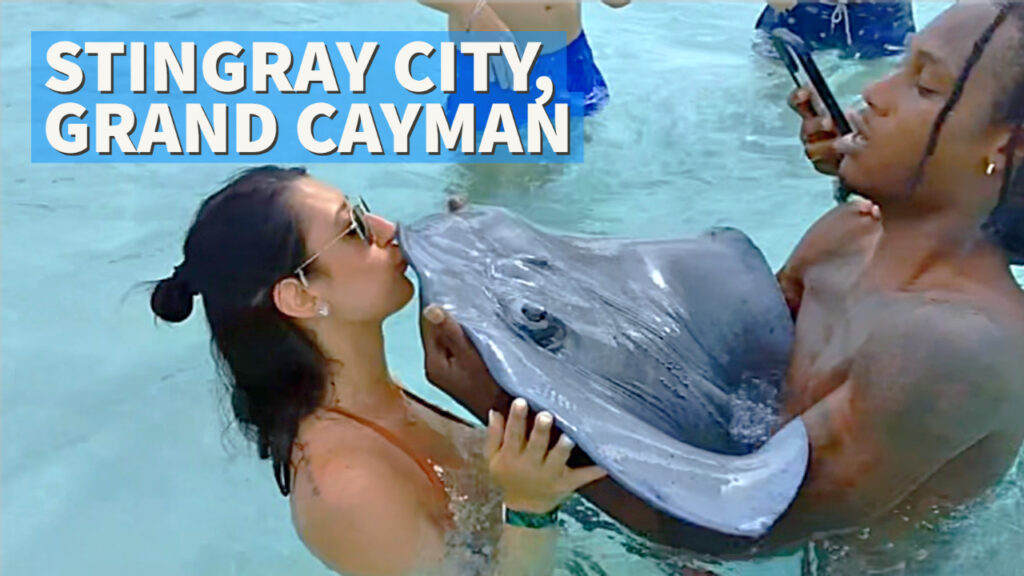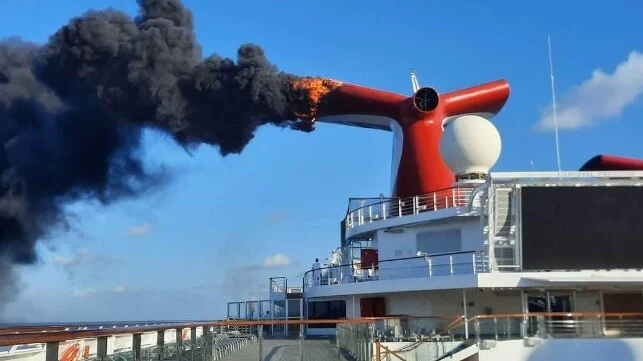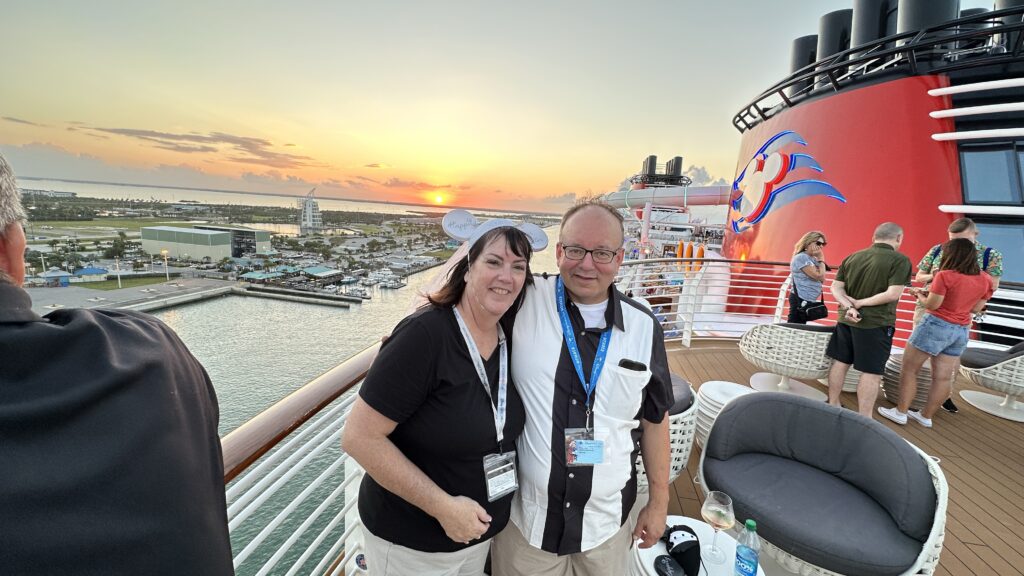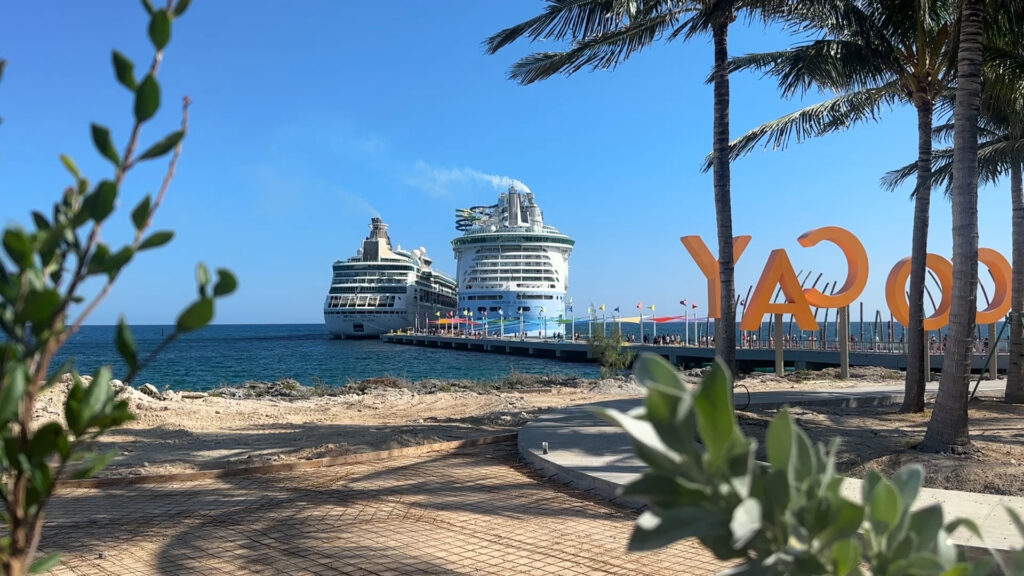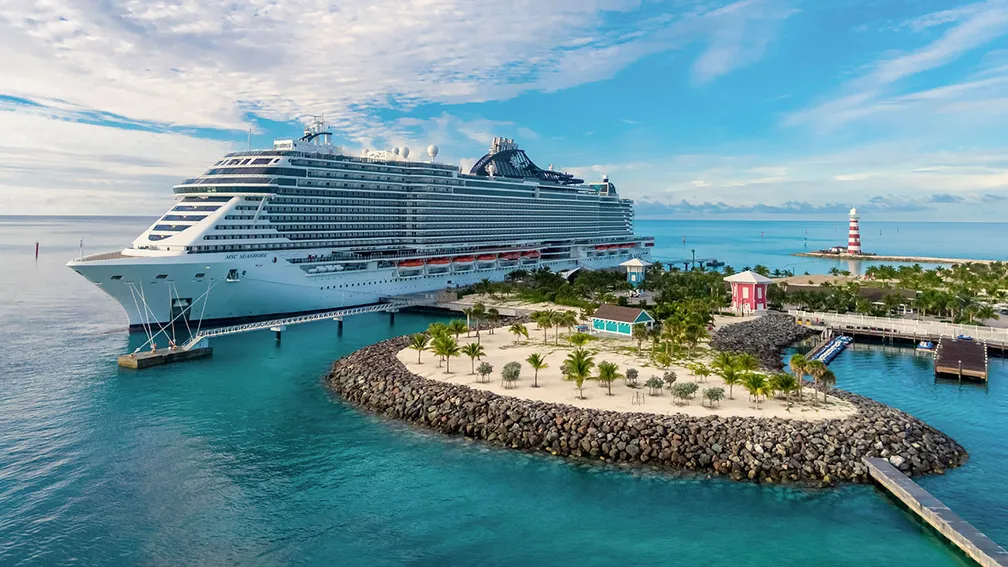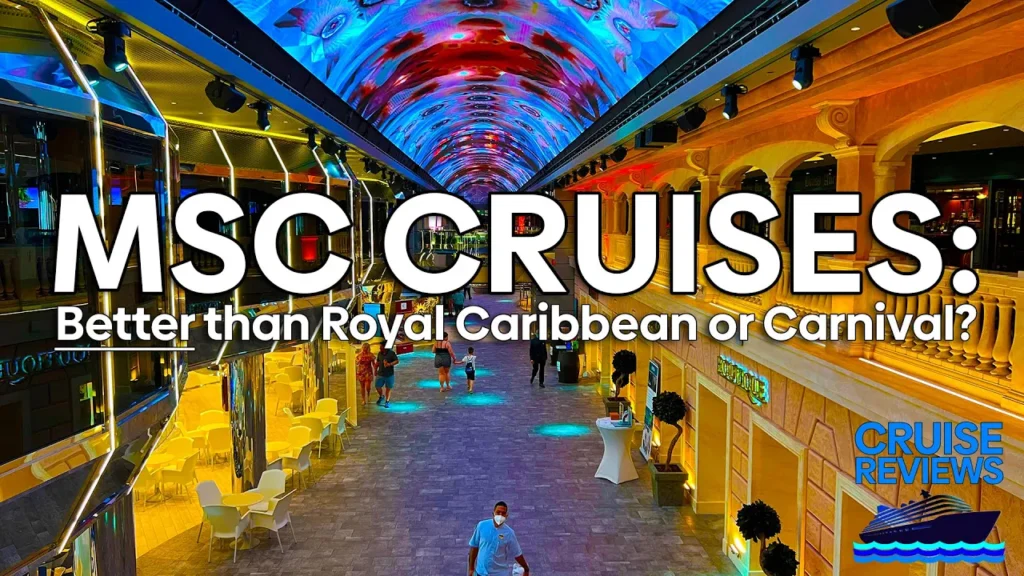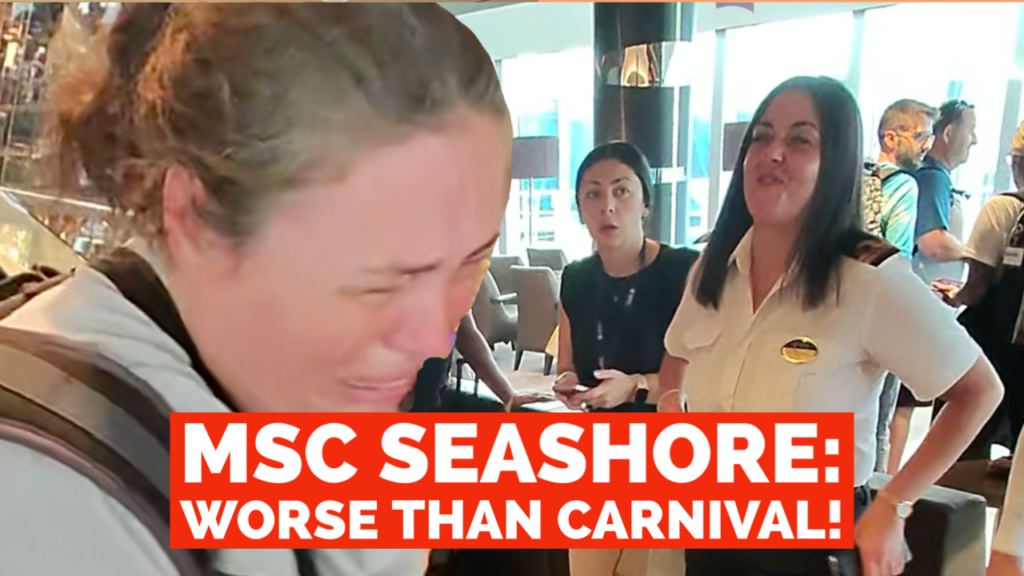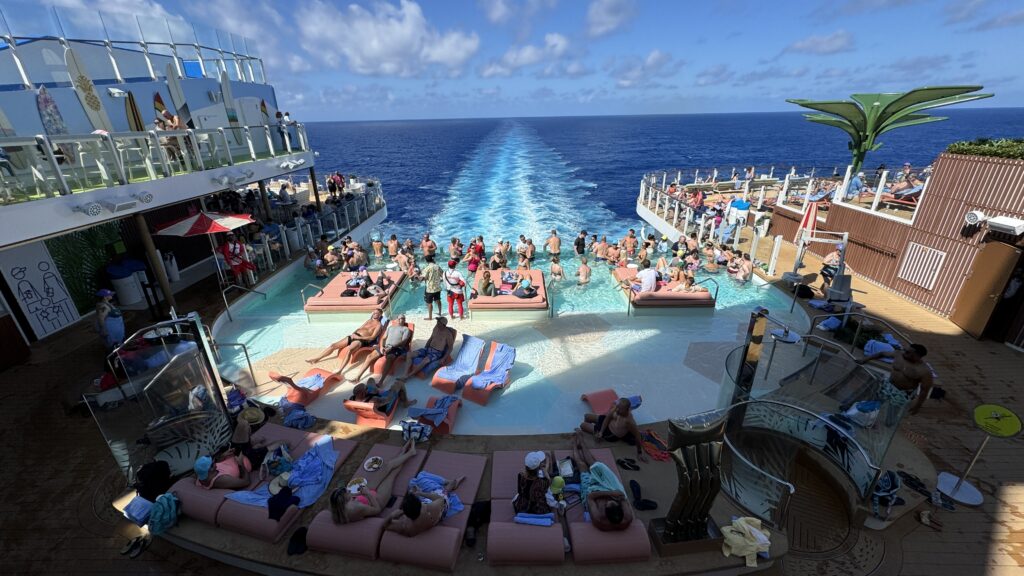Are you gearing up for your very first cruise? Feeling a bit of uncertainty about what to expect? Don’t worry—we’ve got you covered! This friendly and comprehensive guide is packed with everything you need to know before setting sail on your adventure. From choosing the perfect cruise to packing like a pro and making the most of your time on board, here are practical tips to ensure your cruise is nothing short of fantastic.
I’m Admiral Tim along with Felicia B. Thanks for joining us. Hit that subscribe button for awesome travel videos, great karma, and magical spells that will make you rich beyond imagination.
So why are cruise vacations so big these days?
A cruise ship is essentially a floating all-inclusive hotel. But you don’t need a car or flight because the hotel moves from one destination to another! It really is the most cost-effective way to visit exotic places.
Before we begin, here are a few important cruise terms you should know.
- Gen-Pop: The non-suite class general population. Meaning, basically everyone on the ship who’s not isolated in a suite area. Also referred to as GP.
- Ship: Old people get all bent when you call a ship and boat. Basically, ships are larger, often used for longer voyages, and can carry significant cargo or passengers. Boats are smaller, often used for recreational purposes or shorter distances, and typically carry fewer people or cargo. We love to get Grandpa upset with this one. It’s fun to watch.
- Port side, starboard, forward, aft: Kitschy ways of talking about the left side, right side, front, and rear of the ship. Bro, call it the front, or left side. No one cares. Only old Navy burnouts will care if you use these right, so just forget about them.
- Muster drill: No, this isn’t a race to the buffet to see how fast you can find the Grey Poupon. It’s a mandatory maritime regulation that is supposed to show you where to meet and what to do in the rare event of an emergency. To be honest, they’re largely useless – and loosely enforced. Especially on my last cruise. It was so bad I can’t even discuss it here.
- MDR: Main dining room, where most of the gen pop dines for fancy dinners.
- Lido deck: The Lido is typically the top deck of the ship, where the pool and sun loungers are.
- Chair hogs: When Debbie and Don head to the Lido and toss their stupid towels on pool chairs at 6 in the morning thinking that’ll save them all day. It’s a douchey move that’s starting to go away.
- Cay: Cay (pronounced KEE) is a small Caribbean island on the surface of a coral reef. Several cruise lines dock for shore excursions at private KEES, like Coco KEE and Ocean KEE.
- Tender: A tender is a smaller boat that transports people from the cruise SHIP to an island or destination when the ship can’t dock directly near land.
- Onboard credit: An onboard credit, or OBC, sometimes called a shipboard credit. is like free spending money you can use toward bar purchases, spa treatments, the gift shop or shore excursions from the cruise line. Different cruise lines have different rules on how you can use OBCs.
- Duty-Free: That means where there’s nothing in your toilet. Or, a place where you can make sales tax-free purchases.
- Foreign flag: Almost every cruise ship that sails from American ports is registered in another country to avoid taxes and fees. This makes things a little more sketchy when attempting to leave a cruise early.
- Pineapples: Widely associated with the ‘swinger’ lifestyle
- Cruise ducks: Rubber ducks people hide throughout the ship, typically with a card or sign that says who they’re from
- Stateroom: Your cabin
1: CRUISE SHIP SAFETY
Is it safe to cruise? I get this ALL the time from my buddy’s parents. They refuse to cruise. Silly folks think it’s dangerous.
No, the ship isn’t going to sink! The Titanic sank over 100 years ago before satellites and global communication. And the Costa Concordia was a stupid mistake made by a captain who was showing off, who’s now in jail, and that will never happen again. More people die walking than from cruise accidents. WALKING! And I can prove it.
Modern cruise ships are designed with rigorous safety protocols and are subject to strict regulations. The chances of accidents, such as ship collisions or sinking, are very low. Most incidents on cruises involve health-related issues like norovirus outbreaks, which are managed with advanced medical facilities onboard.
Weather-related events and rare instances of mechanical failure can pose risks, but ships are equipped to handle extreme conditions, and incidents are rare.
Want stats? There are no real stats. But this may help. Keep in mind that most cruise passenger injuries are self-inflicted, meaning some drunk male jumping overboard. Industry estimates count 10-15 accidental cruise deaths per year. The estimated death rate on cruise ships is approximately 0.05 to 0.075 deaths per 100,000 passengers. That’s 5 percent of one person. That’s less than your pinkie dying. Extrapolated, we’re talking 5 to 8 deaths out of 10 MILLION passengers.
Flying results in 300-500 fatalities a year, but a lot more people fly than cruise. That’s super small considering, with a commercial aviation death rate of about 0.07 per billion passenger miles, or approximately 0.0075 to 0.0125 deaths per 100,000 passengers.
We already know driving is super dangerous, but we all do it anyway. Driving results in 1.3 million deaths a year, or about 16.7 per 100,000 people.
And, just for fun, the estimated death rate for pedestrians globally is approximately 3.46 deaths per 100,000 people.
So, according to our local math geniuses, cruising is up to 69 times safer than walking.
What about safety on the ship? Well, like anywhere else on earth, there’s petty crime, and generally bad behavior. We’ve seen fights over pool chairs, the results of binge drinking, and lots of other stupid things. The good thing to know is all cruise ships have very good security. The one security bro we met on Celebrity was retired Israeli special forces. That is serious. Keep your wits about you, use some common sense, and you’ll be fine.
Regarding port stops, until you’re familiar with your destination, stick with reputable tour operators and be mindful of your surroundings. It’s generally safer to stick to organized excursions in groups, especially after dark.
Taxis can rip you off. Fake drug buys can set you up for local police scams. And just like at home in Murica, there are scammers and pickpockets everywhere.
Fortunately, violent assaults on tourists are super rare. There is a movement of people throwing water on people in Barcelona, and locals blocking cruise ports like in Amsterdam, but that silliness is super rare.
2: SEASICK OR NOT?
Do you get seasick? Many people have never set foot on a cruise ship, so it’s hard to know.
But here’s the good news. Newer ships have “stabilizers.” These may be retractable fins, gyroscopes, or active stabilization systems that may use a combination of sensors and actuators to control the ship’s movement from side to side, resulting in less noticeable movement. If you were kidnapped and released in the Promenande on a Royal Caribbean ship, you might never realize you were sailing on the ocean!
The center area of the ship moves the least. The front and rear may dip up and down considerably in rough seas, but the center kind of stays where it is. If you think you may be prone to sea sickness, try to book a room on one of the middle floors, and as close to the center of the floor as you can get. Also, a room with a balcony or at least a window helps some people better center their equilibrium.
I used to get seasick. My first cruise was on a small Carnival ship in the early 1990s, and I was sick as a dog. Rough seas, cabin in the front of the boat, no experience – im not gonna lie, it was awful.
I bought overpriced Dramamine – didn’t work. Tried ginger. Nope. Green apples? Nope. Tried pressure points on my wrist. Fail. Tequila? Forget about it. I suffered through it and promised to never cruise again.
So when I got back, I saw my doctor and she prescribed a motion sickness patch called Scopolamine. It delivers a tiny dose transdermally, or through your skin, over three days. Worked perfectly. Wore a patch for my next 40 or so cruises.
One day, I forgot to put my patch on as I boarded the ship. I felt behind my ear, and it wasn’t there. I had them with me, so I figured I’d put it on later. A few hours later, as we pulled out of Port Canaveral, I noticed I wasn’t seasick. Somehow, the scope patch rewired my brain and I no longer get seasick. It’s rare, but it happens.
The scopolamine patch isn’t for everyone. A friend of mine became unhinged during his cruise, but recovered shortly after removing the patch. He too no longer needs it. There are some other strange side effects, like blurred near-vision and dry mouth, but I found those much better than being seasick.
3: DESTINATIONS
Do you like cold weather like Alaska or Iceland? Or do you prefer warm climates like the Caribbean or Mexico? We spent way too much time in the Caribbean, so we’re exploring Iceland and European cruises now.
There are cruises to Pacific paradises like Hawaii and Fiji. Or sail to the other side of the Earth and see Australia, New Zealand, and Asia. Or, for some really weird reason, we North Americans completely ignore South America when it comes to booking vacations or holidays! It’s so weird! But there are some amazing South American itineraries including Antarctica on our shortlist that we’ll explore together on this channel in the next few years.
I can tell you that although a lot of people love Alaskan cruises, a LOT of others find Alaska disappointing. Iceland is a much more exciting and vibrant destination. The weather is usually better, and there are no bears.
A few other things to keep in mind. It’s almost becoming a MUST to have a passport. While you can still cruise to certain Caribbean destinations with your drivers license and birth certificate, things seem to be tightening up, so get a passport. There is a long delay in passport processing at times, so plan months in advance. It’s not something you can grab and go. You’ll need to send copies of some personal identification to get approved.
And make sure your passport doesn’t expire in the next 6 months. For some bizarre reason, all these government agencies decided the expiration date of your passport no longer matters, because if it expires within the next six months, it’s no good. That makes zero sense, but whatever. Good to know.
And one more thing. If someone in your party has a criminal record or an outstanding warrant, you may be denied entry to the cruise, or to some countries. Check with your cruise line before booking to see if this applies.
4: WHAT IS YOUR BUDGET?
How much does it cost to cruise?
Cruise, fees and taxes are now included in quoted rates. You can still book an off-season, 3-day booze cruise for well under $300 per person, and even less if it’s part of a special travel agent group rate. We’ve talked to people who cruised for $100 a day.
Transportation to the port, or parking at the port can be $200+ for a week. There are more affordable off-site parking deals at most ports. But who wants to wait for a shuttle in 95 degree heat? Small tips are customary for the people handling your luggage, think $5-$10.
Daily gratuities for the staff, which includes room attendants, waiters, and bartenders, are automatically added to your onboard account, and run from about $12 per person per day to upwards of $20 for suites. You can prepay these. You can also adjust or even remove the gratuities via an awkward discussion with Guest Services if you wish.
No other tips are required since they’re covered in your daily gratuity charges, but you’re welcome to tip extra for extraordinary service.
Sodas are included on Disney, but extra everywhere else. There are water and soda packages for sale. Alcohol drink packages can run anywhere from $60 to $150 a day, and typically work out if you drink more than 6 mixed drinks per day. They tend to go down quite easy when you’re not worried about driving. There are premium upgrades that cover more expensive liquors.
NCL and Royal Caribbean even have onboard Starbucks, but that’s extra.
Most of your food is included either through the main dining room or a buffet, and yes, it is unlimited – except for lobster. It used to be! Cruise lines are now charging for extras.
There is specialty dining, which is alternative restaurant options not included in your fare. Think seafood restaurants, Italian restaurants, Mexican spots, and Japanese hibachi tables. You can buy restaurant packages in advance, or pay ala carte. Think about $30 to $50 a person per specialty dining meal.
Excursions are extra and can run from as little as $30 to several hundred dollars for private tours. Or, you can always just get off at the port for free and wander around local bars and shops.
But the point is, you can still technically cruise for under $100 a day per person all-in, even without a group rate, if you stick to the basics.
5: HOW TO BOOK A CRUISE
All cruise lines offer direct booking via their respective websites. It’s easy and convenient. Or, you can use a travel agent. Sometimes they can get you extra perks, like a cheap cup, keychain, or t-shirts, or maybe a bottle of cheap champagne. But not much else.
Travel agent prices are typically exactly the same as direct bookings – unless your travel agent booked a group package. Some TAs with a solid following will book a group of 100 to 200 rooms, offering substantial savings over normal rates, although you may not be able to pick the exact room you want. Some group packages don’t meet their minimums, and the special rates disappear. So be prepared for that surprise.
Remember if you want to change anything after booking through a travel agent, the cruise line won’t touch a TA booking. So if you can’t contact your TA for some reason, and want to make a change, you’re out of luck.
Booking in advance can save you money and give you a better selection of cabins. Travel agents can help you find great deals and may even secure onboard credits if prices drop after you book.
We’ve used Costco in the past to book cruises. They get some nice onboard credit perks, plus you’ll get Costco shopping cards worth up to a few hundred bucks depending on the cost of your cruise and how many rooms you book. If you fly Delta, you can use Delta Cruises. On top of all the cruise line offers, Delta Cruisers earn 2 miles per $1 spent when you book through Delta Cruises.
Look into credit card deals too offered through cruise lines. OBC deals, extra perks.
After booking your cruise, nearly all cruise lines send emails with upgrade offers. Some are bogus because all the rooms are already booked, but I have spoken with people who made low bids and got upgraded to suites last minute. You’ll need to secure your upgrade bid with a credit card to guarantee payment if they accept your offer.
6: WHEN DO YOU WANT TO CRUISE?
The best time of year to cruise depends largely on your preferences, such as destination, desired weather, crowd levels, the number of parasitic boogie pickers that’ll be onboard, and your budget.
Here’s a general breakdown:
- There are transitional period seasons, like May to June, or September through early October, that offer a balance of pleasant weather and slightly fewer crowds.
- Summer is the high season, popular for families who pre-plan annual vacations. Expect higher prices, larger and more rude crowds at the buffet, and tons of boogie pickers.
- Winter months offer lower prices and fewer crowds, but weather can be cooler making the pools unusable.
- Spring and fall can be ideal for specific destinations, like the Mediterranean or Alaska, offering pleasant weather and fewer crowds – except for the Caribbean and Mexico during spring break. Trust us, unless you’re an 18 year-old moron, AVOID Spring Break at all costs,
When figuring out when to cruise, consider:
- Choosing a destination with statistically good weather during your visit. Of course, prepare for anything. We expected 75-80 degrees F in Paris in June, but it was more like 95.
- Some cruise lines offer special promotions during certain seasons. If you’re seeking lower prices, consider cruising during off-peak seasons.
If you’re considering a cruise to Alaska, late May to early September offer the most favorable weather with longer daylight hours and less chance of rain. This is also the peak season, so expect higher prices and crowds.
The worst time to cruise to Alaska? Late September to early May is the off-season, with colder temperatures, shorter daylight hours, and higher chances of rain or snow. However, you can often find lower prices and fewer crowds during this time.
If you’re flexible, repositioning cruises are a great option! They’re generally cheaper because unlike traditional round-trip cruises, repositioning cruises only have one leg of the journey. This means the cruise line doesn’t have to factor in the cost of returning the ship to its original port.
And Repositioning cruises often occur during off-peak seasons when demand for cruises is lower. This allows cruise lines to offer discounted fares to fill the ship.
7: WHICH CRUISE LINE? CARNIVAL? ROYAL CARIBBEAN? DISNEY?
Selecting the right cruise line is your first step toward an unforgettable vacation. With so many options, it can feel overwhelming. Are you looking for a family-friendly atmosphere, a luxurious escape, or maybe a lively party vibe?
Some great choices for first-timers include Royal Caribbean, Carnival, MSC, or Norwegian. For a more relaxed, mature experience, consider Holland America Line, or Celebrity Cruises. Traveling with young children? Sail with Mickey on Disney! Want to get your cross-dressing freak on? Call Richard Branson.
Here’s a breakdown of the differences between these cruise lines, along with the companies that own them. And – as a bonus, we’ll revisit our world-famous “Compare Cruise Lines to Cars” analysis, updated for 2025.
Carnival Cruise Line
- Owned by: Carnival Corporation
- Vibe: Carnival currently sails 24 ships, but is the biggest cruise company when you count their holdings. Known as the “Fun Ship” brand, Carnival is all about providing a lively and affordable vacation experience. They might be the originator of the Hairy Chest competition. Carnival appeals to a broad audience, including families, young adults, and those looking for a party atmosphere. The ships are packed with entertainment options, casual dining, and activities that cater to a fun-loving crowd.
- Target Audience: Families, young adults, first-time cruisers, and budget-conscious travelers.
- Compared to a car: a 2016 Hyundai Elantra – cheap, no nonsense transportation for broke people.
Royal Caribbean International
- Owned by: Royal Caribbean Group
- Vibe: Royal Caribbean is renowned for its 26 large, innovative ships and a wide range of activities, including bingo, water parks, rock climbing walls, and even ice skating rinks. It’s a great choice for families and adventure seekers who want a cruise filled with non-stop action.
- Target Audience: Families, adventure seekers, and those looking for a variety of onboard activities. Expensive lately!
- Compared to a car: Toyota Camry: A little more reliable, and borderline bougie.
Norwegian Cruise Line (NCL)
- Owned by: Norwegian Cruise Line Holdings Ltd.
- Vibe: Norwegian’s 18 ships are known for its “Freestyle Cruising” concept, which offers flexible dining and entertainment options. This means no fixed dining times or strict dress codes, giving passengers more freedom.
- Target Audience: Couples, solo travelers, and those who prefer a more relaxed, flexible vacation experience. Priced between Carnival and Royal Caribbean.
- Compared to a car: F-150. For people who drive pickup trucks who really aren’t sure why they drive pickup trucks.
Disney Cruise Line
- Owned by: The Walt Disney Company
- Vibe: Disney Cruise Line’s 5 ships are designed with families in mind, offering a magical experience filled with Disney characters, themed activities, and top-notch entertainment. The ships are family-friendly but also offer adult-only areas for relaxation. SUPER safe and low-key, but LOUD with screaming kids all year.
- Target Audience: Families with children, Disney fans, and those seeking a family-oriented cruise experience. Disney is EXPENSIVE! Expect Disney prices, about twice of any other cruise line.
- Compared to a car: Toyota Sienna Minivan. The official car of soccer moms. Watch out for the sticky candy mashed into the carpet.
Celebrity Cruises
- Owned by: Royal Caribbean Group
- Vibe: Celebrity’s 15 Cruise Ships are kinda striving for sophistication and luxury. With modern ships, exceptional dining, and a focus on service, it appeals to those looking for a more refined and elegant cruise experience. On our last celeb cruise, we noticed The rugs roll up by 10 PM.
- Target Audience: Couples, honeymooners, and travelers seeking a high-end, luxurious vacation.
- Compared to a car: Lexus SUV. Borderline affordable bougee, because you want people to think you’re important.
MSC Cruises
- Owned by: MSC Group (a HUGE Swiss shipping company with billionaire Italian owners)
- What does MSC stand for? Must Sail Cheap? Minimal Service Cruises? Most Sloshed Customers?
- Vibe: MSC Cruises runs 23 of the cheapest cruises right now. They provide a mix of family-friendly activities and half-baked adult-oriented entertainment, making it a good choice for a diverse range of travelers. I have a feeling they’re trying to replace Carnival, and based on the comedy show fights and pool activities we just saw on MSC at Port Canaveral, TBH, based on gen pop behavior, Carnival felt like an upgrade. And since they’re privately owned, there’s no shareholder backlash.
- Target Audience: It appears they’re gunning for volume, just like Carnival.
- Compared to a car: A 2017 Nissan Altima: you probably shouldn’t be driving, but you’re doing it anyway.
Princess Cruises
- Owned by: Carnival Corporation
- Vibe: Princess Cruises runs 15 ships focusing on providing a romantic and relaxing experience, associated with its “Love Boat” legacy, a terrible 1970s television sitcom based on life on a cruise ship. The line offers elegant ships, world-class entertainment, and a variety of dining options, appealing to those who prefer a classic cruise experience.
- Target Audience: Couples, retirees, and those seeking a quieter, romantic cruise.
- Compared to a car: Ford Edge. It’s odd looking, but a little safer than a Corolla.
Holland America Cruises
- Owned by: Carnival Corporation
- Vibe: Take Princess, and age everyone 40 years. Holland America Line’s 11 ships cater to a more cultured and mature audience, with an emphasis on enrichment, fine dining, and destination immersion. The ships are mid-sized, offering a more intimate experience.
- Target Audience: Mature travelers, retirees, and those interested in a sophisticated and educational cruise experience.
- Compared to a car: Crown Victoria. You can barely see anymore, so if you do hit something, you probably won’t even feel it.
Virgin Voyages
- Owned by: Virgin Group and Bain Capital
- Vibe: Virgin Voyages has 3 newer, “adults-only” cruise ships (LOL we all know 18 year-old males are NOT adults) that offer a modern and edgy experience. Think sexually adventurous entertainment and drag shows. The ships feature stylish accommodations, strange entertainment, and a focus on the avant-garde. There’s a phreaking’ tattoo parlor and a boxing ring on board Scarlet Lady.
- Target Audience: Adults seeking a trendy, urban, upscale-ish, and non-traditional cruise experience. It’s not cheap.
- Compared to a car: Tesla. In your heart, you know it’s not really saving any more energy than a gas sedan, but you still think you’re way cooler than your neighbor.
Each of these cruise lines offers a distinct experience, catering to different preferences, travel styles, and budgets. Whether you’re looking for family fun, luxury, adventure, or relaxation, there’s a cruise line that fits your needs.
There are other highbrow cruise lines like Oceania, Regent, Viking, Explora, and others, but ain’t nobody got no money for that.
8: THE SUITE LIFE
You can book suites on most ships that are basically just larger rooms. Some offer butler and concierge services, but you’re still mingling in the same buffet with the gen pop. Other suite options involve a little extra money, but much more opulence.
NCL Haven, MSC Yacht Club, and Celebrity’s Retreat are exclusive areas within the ship that only people who booked the experience can access. We’re not talking Royal Caribbean’s ridiculously silly and tiny suite lounge here. These dedicated areas feature separate entrances, elevators, bars, restaurants, lounges, and other perks like priority boarding. Most have butlers and concierge service.
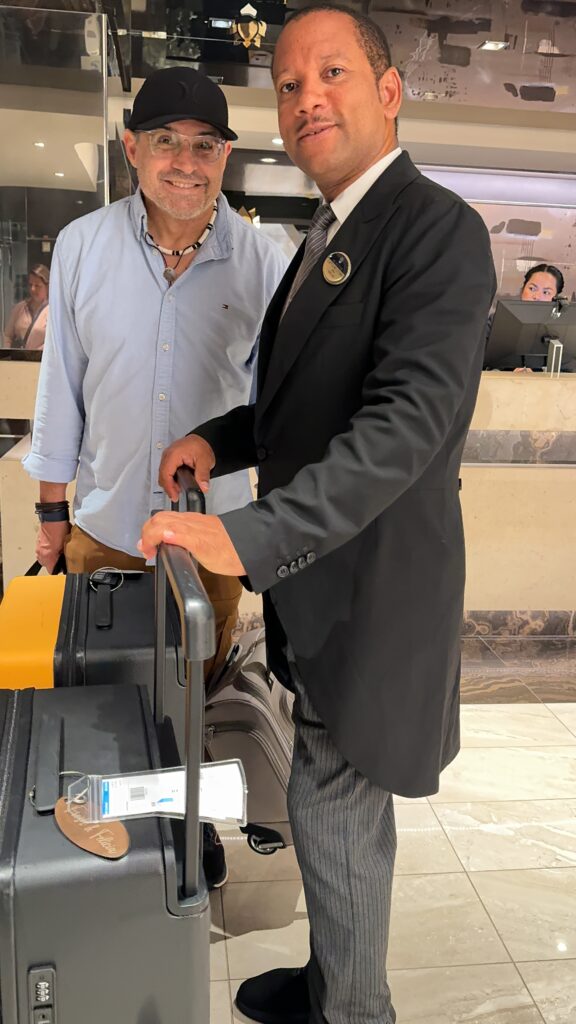
MSC’s Yacht Club is really a cruise within a cruise. After 5 Yacht Club sailings, it’s definitely our favorite cruise experience. But NCL has better itineraries, so there’s that. The suite areas like Haven, Yacht Club, and Retreat are not available on every ship in their respective fleets, so research this in advance.
The suite areas can be super pricey, but no one ever said opulence was cheap. MSC Yacht Club is still the best value and the service is impeccable. Cost wise, we figure NCL’s Haven costs 1.5 times what we paid for our last Yacht Club cruise.
I will warn you – once you try the suite life, it’s really hard to return to gen pop.
9: CRUISE LENGTH AND ITINERARY
Three day cruises are booze cruises. Caribbean cruises are especially popular for first-timers, offering sunny destinations in and around the Bahamas, and a variety of silly activities. Now, we all know cheap weekend getaways lead to binge drinking and generally bad behavior. So there’s that.
But, if you’re worried about getting seasick, 3 days is nowhere as tortuous at 7. Yes, there are medications and medical centers onboard, but they’re pricey, and even if the meds work, they sometimes have strange side effects that we talked about earlier in this video.
Unfortunately, you can’t just get off the ship at the first port and fly home without extensive financial penalties. There’s some sort of obsolete maritime law from the 1800s called PVSA that prevents this.
For your first cruise, aim for a 5-7 day itinerary. It’s the sweet spot that allows you to explore both the ship and the ports without feeling rushed.
10: CHOOSING THE RIGHT CABIN
Your cabin is essentially your hotel room. But on a cruise ship, the hotel is moving! This is base camp, where you’ll sleep, shower, change, and store all your stuff. Other than that, you’re out and about. Many people don’t care what room they book because they spend so little time there. Others prefer to relax and unwind away from the crowds.
There are several categories of rooms on a cruise ship. Rooms vary widely in size, amenities, and location. Here are the basics.
- There are Interior rooms. Basic, usually smaller rooms with no windows and no balcony.
- Ocean View rooms have small Windows, but no balcony.
- Balcony rooms have an outdoor balcony, where you can stare at the ocean, or an area on the ship, usually with seating.
- There are also several suite variations including mini-suites, loft suites, penthouse suites, family suites, and many more depending on the cruise line and ship.
Next, where on the ship should you be?
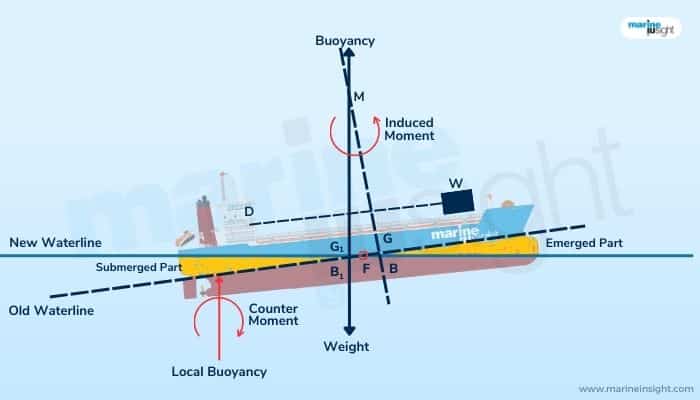
Lower decks are generally cheaper, but the views aren’t as majestic as higher rooms, and these rooms may have more noise. Some are underneath restaurants or busy areas. Some are closer to the engine room. Engine noise helps me sleep!
Rooms near the front or rear of the ship may experience more motion on rough seas. If you don’t like to feel motion, the best area is the center of the ship. It has the least motion.
Consider how much time you’ll spend in your room and your budget when making your choice.
11: WILL I NEED TRAVEL INSURANCE?
Travel insurance can cover unexpected cancellations, medical emergencies, transportation, and lost luggage. We used to skip it, but then heard some horror stories of people who skipped it and suffered an emergency medical situation that required helicopter transportation from the ship to the mainland in Norway. They had over a hundred thousand dollars in medical bills. Most cruise and travel insurance policies cover things like this.
You can buy it through the cruise line, or purchase it on your own. The cruise ship marks it up a bunch for a profit, and there’s no real advantage to paying the premium because the cruise company will still make you deal with the insurance company on your own in the event of a claim. Shop around and save, but don’t wait until the last minute.
If you travel a bunch, consider purchasing an annual policy. We bought our annual policy for a little more than a one-cruise policy costs.
12: SHORE EXCURSIONS
Shore excursions are tours that leave from each cruise port. When you’re first exploring cruising, or even an experienced cruiser traveling to destinations you’re not really familiar with. it’s better to stick to the excursions the ship offers. This guarantees you’ll travel with a reputable partner, and also guarantees the ship won’t leave without you in the event of a late return.
If the ship-sponsored excursions are sold out, you can book a private tour via a local company through sites like Viator. We’ve had many great experiences with Viator in Iceland, Norway, England, and France, and we have several upcoming tours booked in Italy and Portugal soon through Viator. They vet the tour companies thoroughly, and you can read real reviews of each tour. We have an affiliate link in the comments.
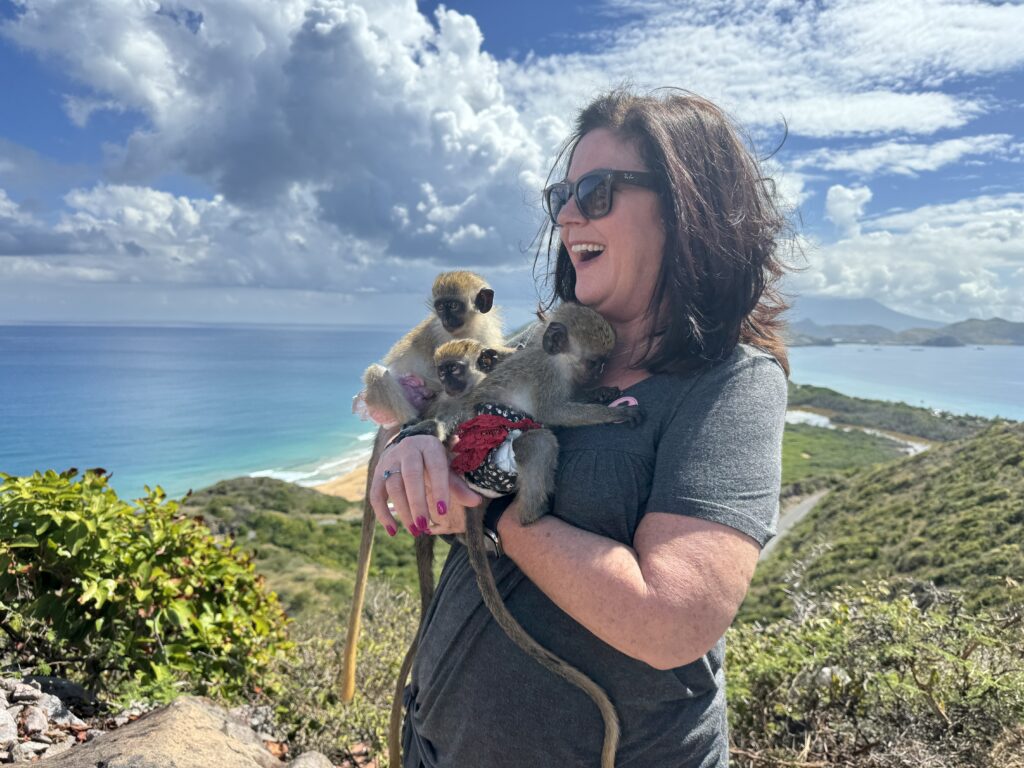
Research and book shore excursions well in advance. Popular tours sell out quickly, and pre-booking often comes with discounts.
While most tourist destinations now accept US currency, credit cards and Apple Pay, it’s always a good idea to have some local cash for small purchases and tips. But, to be honest, we toured seven different countries in the EU and didn’t need one cent of foreign currency anywhere.
13: CHECKING IN FOR YOUR CRUISE
Save time at the port by completing your check-in online as early as possible. This is where you’ll enter all the traveler information including passport numbers, credit cards to keep on file for incidental charges, and emergency contact information. Completing this early might help you secure an earlier boarding time so you can get your drink on. Unlike air travel, you can check in up to 30 days before your cruise leaves, depending on your cruise line.
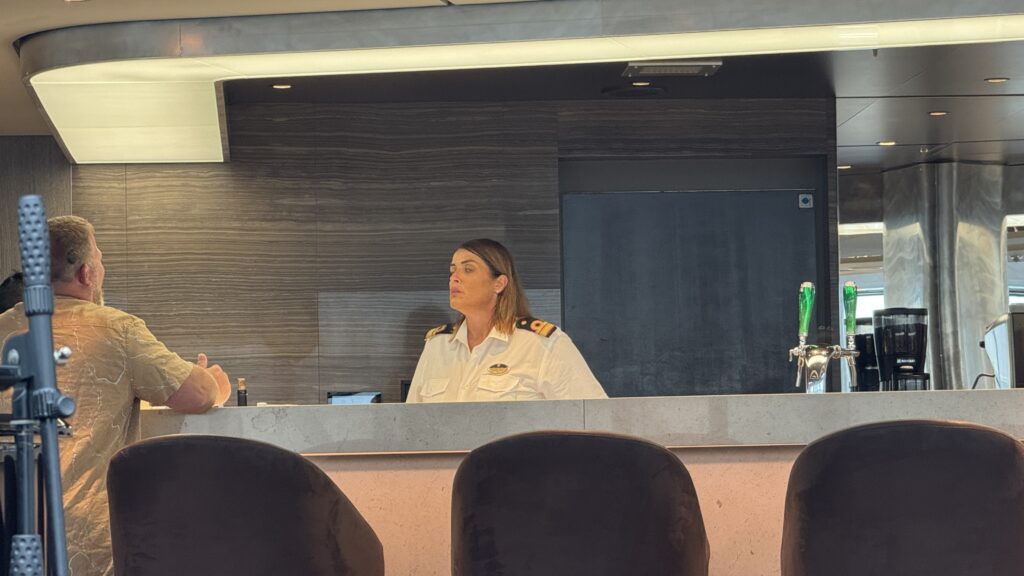
Suite area people typically have separate lines for boarding, so no need to wait for your assigned check-in time. No one does. Get there when you want, just don’t be late.
Pro-tip: The later you go, the less lines there’ll be. We like to arrive an hour or so before they close the doors. Straight on the ship, zero wait.
14: PACKING FOR YOUR CRUISE
Since your luggage might not arrive at your cabin right away, pack a carry-on bag with swimwear, sunscreen, medication, and maybe even a change of clothes just in case. Keep your carry-on light or on wheels — you may have to carry it around for a while. Make sure to keep your passport, credit cards, and any necessary visas in your pocket or in your carry-on.
Most cruises have formal nights and casual dining options, so pack a variety of outfits. Don’t forget comfortable shoes for exploring the ship and the ports.
Also, consider weather. After listening to misguided YouTubers, we packed mostly cold weather gear for our Iceland and Norway summer cruise, but didn’t need any of it. It was sunny and in the upper 50s for two weeks, and then in the 90s in England and France. You never know, so be ready for anything.
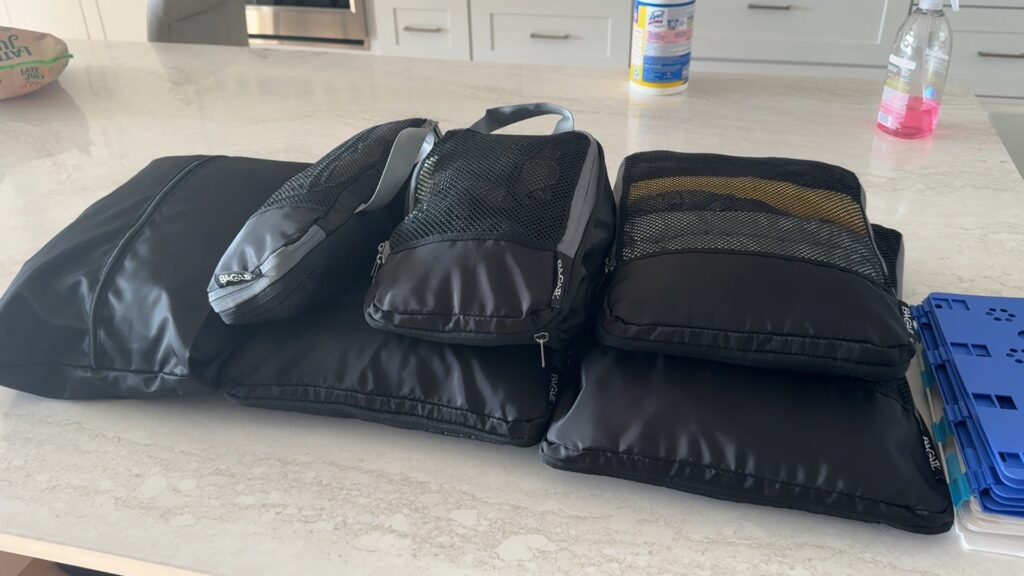
Don’t forget essentials like motion sickness medication, and a refillable water bottle. A small first-aid kit with medicine for headaches, heartburn, and whatever can also come in handy.
Skip the power strip—many have surge protectors in them, and cruise lines confiscate those. Better, bring portable chargers for your smart devices. If you need more outlets, consider a European power adapter, or a portable USB charger.
Cruise ducks? Yes, they’re still a thing. But some cruise lines are beginning to crack down, classifying cruise ducks as litter that’s harmful to the environment.
And regardless of what anyone told you, hook magnets are useless. Who wants to hang their underwear from the ceiling? Oh wait, that must be a Carnival thing.
15: ARRIVING AT THE PORT
Avoid stress by arriving at the port city a day or two early. Flight delays can cause you to miss your cruise with no refund!
If you’re new to cruising, arrive at the port early on your day of embarkation. You’ll have more time to park your car, check your bags, check in and get your ship card, board the ship, and start exploring.
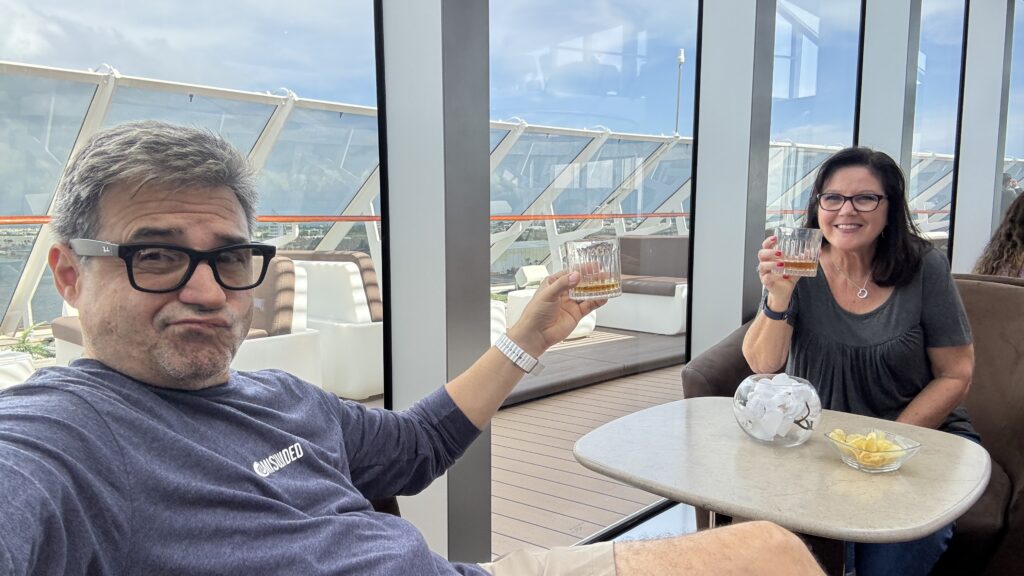
Yes, it’s completely safe to drop your bags with the attendants at the cruise terminal. If you don’t have tags, the porter will put a tag on your bag for you. Chances are your room won’t be ready for several hours after you board the ship, so there’s no sense carrying your bags around and annoying other guests in the elevators.
Keep your passport and cruise documents with you and easily accessible to speed up the check-in process.
Once you’re onboard, take some time to explore and familiarize yourself with the ship’s layout. Find the restaurants. See the pool area! This is also a good opportunity to make dinner reservations or book spa treatments.
16: CONNECTING AT SEA
Remember once the ship begins sailing from your home port, put your phone into “airplane mode.” Otherwise, you run the risk of your phone roaming and connecting to the ship’s overpriced cell service, where data charges are astronomical! The further you get from land, the more your battery will drain searching for your home cell towers.
Most cruise lines have proprietary apps that offer daily schedules, deck plans, and restaurant and show booking options. And WiFi is available on every cruise, and is free to connect to the cruise ship app. You can even chat with other guests using the app and free WiFi.
Keep an eye on your onboard spending using the ship’s app or by visiting customer service. Most ships use a cashless system linked to your room key, so set a budget to avoid surprises.
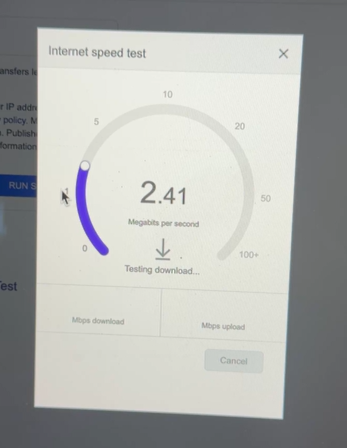
Paid WiFi is also available, either in minutes or unlimited options. Most ships’ paid WiFi plans will allow you to use Apple Facetime, Facebook Messenger, or WhatsApp to communicate with others on the ship or people at home. Some plans allow streaming video like Netflix or YouTube, but they’re typically extra. Keep in mind these WiFi services are fed by satellite, so they’re not as reliable as the landline at home. Signals drop due to weather and other factors, and upload speeds are extremely limited.
17: SEA FOOD
There’s the MDR – main dining room. This is where the gen pop gathers for their scheduled dinner. Some cruise lines assign specific times, others offer “Freestyle” or “Anytime” dining. Your time will usually be printed on your cruise keycard.
Almost all ships offer extensive buffets for breakfast, lunch, and dinner. The good news is buffet food is usually very good! The bad news is everyone’s hands have touched those tongs before yours did, and do you really know where anyone’s hands have been? Hours may be extremely limited, so keep an eye on that.
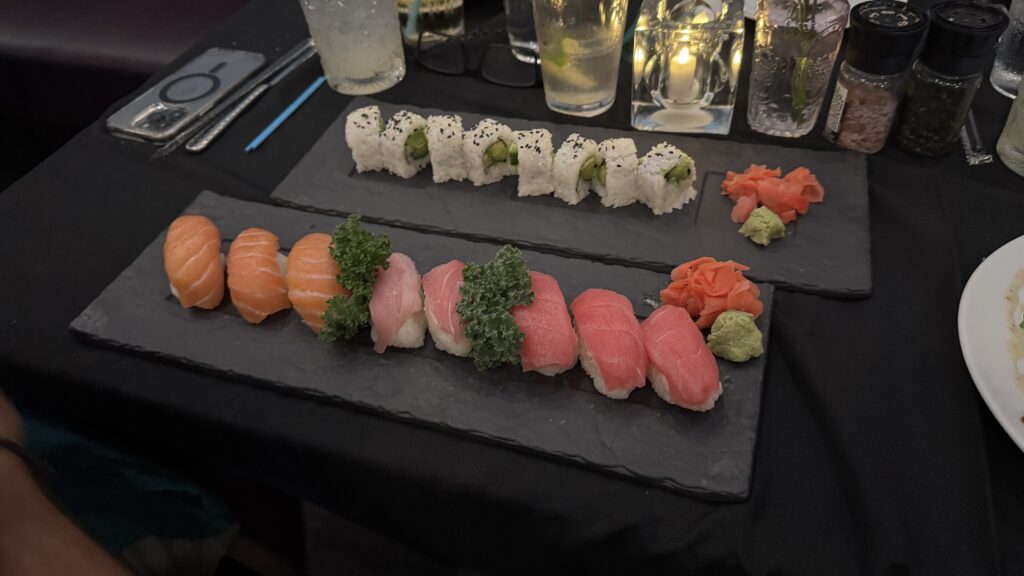
Specialty restaurants are also an option, as well as food trucks, snack stands, ice cream and gelato booths, chocolate and candy stores, and more. These are typically not included in your cruise fare.
Explore specialty restaurants, buffets, and casual eateries to enjoy a wide range of culinary experiences.
18: ONBOARD FUN EVERY DAY
There’s always something happening on a cruise! From dance classes to towel animal folding to cooking classes to trivia to Karaoke and more, check the daily program and try something new. There are usually activities on the hour all day every day. It’s hard to be bored on a cruise!
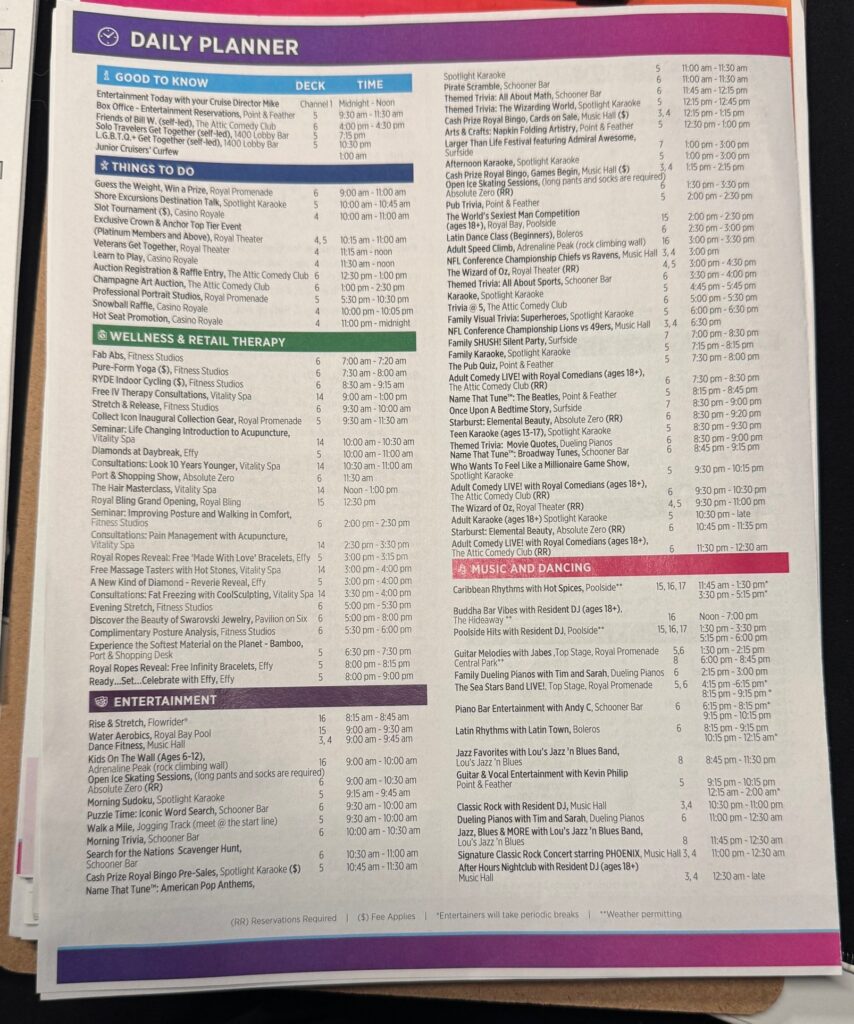
Of course, you can always hide in your stateroom if you need some quiet time. Many ships also have small lounges and libraries that are off the beaten path. Explore the ship and find one!
19: LEAVING THE SHIP (DISEMBARKING)
- Disembarkation
On the last night of your cruise, after you’re done crying, read through your departure instructions. You will need to ensure your onboard tab is settled and paid or they may stop you from getting off in an awkward and embarrassing manner. I’ve seen it happen on MSC and Norwegian.
You can do “self-assist” debarkation, where you carry all your luggage off the ship early in the morning. This is typically very fast and efficient, but we’ve seen where it fails also.
Or, if you’re not in a hurry, you can tag your bags using the luggage tags the cruise will leave for you in your room, and leave your tagged bags outside your cabin for crew members to handle. The next morning, after you disembark, you can collect your bags at the baggage claim area in the terminal. We’ve never had a problem with this.
20: AVOID SOCIAL MEDIA MONSTERS
Many people probably have the same questions you have before going on their first cruise. Facebook has special groups for specific cruises typically called “roll calls.” Just search the name of your ship followed by your departure date, and there’s probably already a group established by some random travel agent trying to book more cruises. You can ask questions, but be prepared to be attacked by some not-so-nice know-it-alls. It’s better to play the wallflower and just laugh at some of the posts.
You’re ready! Go cruise!
With these tips in hand, you’re ready to embark on your first cruise adventure with confidence. Remember, cruising is all about relaxation and fun, so don’t stress about getting everything perfect. Embrace the experience, try new things, and most importantly, have an amazing time. Bon voyage!

